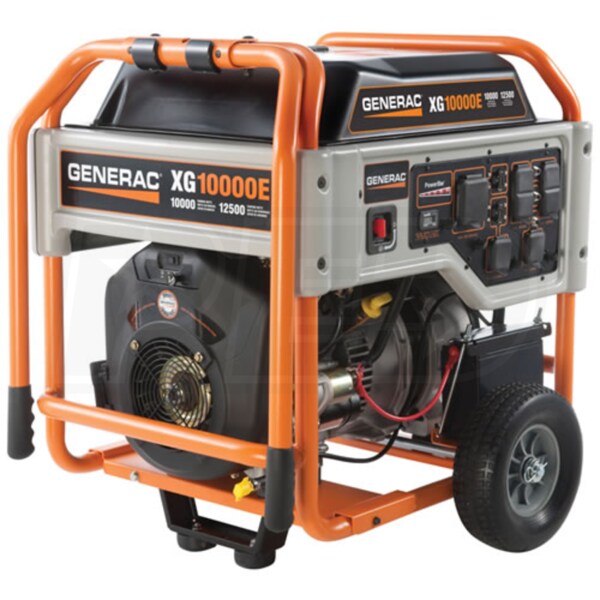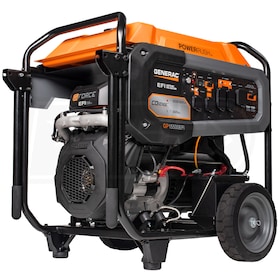Local Pickup FAQ's

Hover to zoom
1 Of 5
Sorry, this product is no longer available.
Try this product instead
Model:
7705
$3,999.00
Backordered

Generac XG10000E - 10,000 Watt Electric Start Portable Generator (49-State)
Model: XG10000E
Product Discontinued
Accessories
Features
Specifications
Reviews
How-To Articles
Manuals
+
Share This Product
Recommended Accessories
Expert Recommended Accessories
Selected by Jared, our Expert
Required Accessories
9
These accessories are required to properly setup/install this product.
Optional Accessories
10
Features
Grade
Semi-Pro
Style
Portable
Run Watts
10,000 Rated Watts
Surge Watts
12,500
Starting Watts
Fuel
Gasoline
Engine
Generac OHVI
- Generac XG Series 10000E Portable Generator
- Ideal for job site or home backup power
- Electric Start (Battery Included)
- Simple, push-button design for easy starting
- 530cc Generac OHVI® Engine
- Designed specifically for generators
- Provides longer life and longer maintenance intervals
- Full Pressure Lubrication w/ Low Oil Shutdown
- Automotive style spin-on oil filter
- Prevents engine damage during a low-oil event
- 10-Gallon Steel Fuel Tank w/ Built-In Fuel Gauge
- Allows for up to 10 hours of run time @ 50% load
- Fuel-shut off switch helps prevent stale fuel in carb
- PowerBar™
- Makes it easy to monitor power wattage
- LED Illuminated Control Panel
- Provides easy panel visibility in low light conditions
- 120/240V 30-Amp (L14-30R) & 50-Amp (14-50R) Receptacles***
- Allows for connection to a manual transfer switch (MTS)
- Allows for connection to a convenience cord
- Heavy-Duty, 1 1/4" Steel Tube Cradle
- Full-wrap design protects your investment
- Covered Outlets
- Provides added safety and keeps dirt/debris out of outlets
- External Battery Charge Jack (Includes Charger)
- Plug in your generator when not in use to keep battery charged
- Portability Kit
- 10" Semi-solid wheels and folding handles
- 2-Year Residential & 1-Year Commercial Limited Warranty
- Non-CARB Compliant - Not For Sale In CA
- ***Note - Allows You To Get Maximum Power From Generator
California residents see
Warning: This product can expose you to chemicals including Carbon monoxide which is known to the State of California to cause Developmental Harm.
For more information go to: www.p65Warnings.ca.gov
Specifications
Plug Types





XG10000E

Overview
Assembly Required
Yes
Weight
300 Pounds
Made in USA
Yes
Consumer Warranty
2 Years
Commercial Warranty
1 Year
Product Style
Portable Generator
Product Length
30 Inches
Product Width
29.5 Inches
Product Height
31 Inches
UPC
696471058024
Additional Model Numbers
5802, XG10000E
Product Specs
Voltage
120/240 Single-Phase
Frequency
60 Hertz
Alternator
Brush
Auto Voltage Regulation
Yes
Rated Watts
10000 Watts
Surge Watts
12500 Watts
Fuel Type
Gasoline
Rated Amps
42 Amps
Portability Kit
Never Flat Wheels
Tank Size
10 Gallons
Run Time @ 50% Load
10 Hours
Fuel Tank Material
Metal
Fuel Gauge
Yes
Decibel Rating @ 7m

Decibel Rating @ 7m
Sound levels are measured in decibels (dB). The lower the decibel rating, the less noise the product makes. As an example, a ticking watch is 20 dB while on the other end of the scale, a lawn mower is around 90 dB.
Not Measured by Manufacturer
Idle Control
No
Hour Meter
Yes
Voltage Meter
No
Lifting Eye
No
Battery
Included
Grade Type
Semi-Pro
Engine
Engine Brand
Generac OHVI
Starting System
12-Volt Button Start
CC
530 CC
Consumer Engine Warranty
2 Years
Commercial Engine Warranty
1 Year
Engine RPM
3600 RPM
Low Oil Alert/Shutdown
Yes
Cast Iron Sleeve
Yes
Plugs
NEMA 5-20R - GFCI
2
NEMA L5-30R
1
NEMA L14-30R
1
NEMA 14-50R
1
Reviews
(164)
Generac XG10000E Reviews & Ratings
How-To Articles
How to Pick the Perfect Professional Portable Generator
A professional jobsite generator gives you the portable power you need for cons...
How to Keep Your Cool After a Hurricane
We've all procrastinated before. Maybe it was for an unpleasant project th...
How to Pick the Perfect Portable Emergency Generator
We don't realize how much we rely on electricity until it's gone. Without power...
Manuals
Ask A Question!
*Required Fields
+
 Thank You For Submitting Your Question
Your submission has been sent successfully. Please give our experts up to two business days to respond.
Thank You For Submitting Your Question
Your submission has been sent successfully. Please give our experts up to two business days to respond.

Media Gallery
Generac XG10000E - 10,000 Watt Electric Start Portable Generator (49-State)


Customer Review Images






